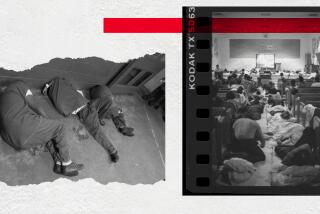LIFE IN LEAVENWORTH
- Share via
Re Pete Earley’s latest book, “The Hot House,” (Feb. 16):
The Bureau of Prisons believes that the public should be made aware of several facts. Specifically, the book gives the average citizen an interesting but narrow view of life and work in a high-security prison. It’s a good book as far as it goes--catering to America’s fascination with the criminal extreme. But it falls short in several areas, distorting a great deal of the picture it attempts to portray.
Mr. Earley focuses on a small group of particularly notorious inmates and an equally limited and unrepresentative group of correctional staff. While their experiences and comments are sometimes rather surprising and colorful, they should not be used as the basis for characterizing the entire inmate population and staff of the U.S. Penitentiary at Leavenworth, much less of the Bureau of Prisons as a whole.
Mr. Early clearly has missed seeing the critical balances between security and self-improvement programs, supervision and productive activity, control and humane treatment, which keep a major prison running every day. Indeed, Mr. Earley missed the essence of Leavenworth--bustling factories, active literacy programs, effective drug treatment, cultural diversity, dedicated community volunteers. He seems unable to grasp how 1,200 of the most sophisticated, dangerous individuals in this country can live together in close proximity yet maintain relative calm. If, as “The Hot House” would lead its readers to think, Leavenworth is such an erratic, anarchic place, under the supervision of venal, callous, vulgar staff, why did it run so well for Mr. Earley’s two years there, and has done so both prior to and since these two years?
At this level, the book leaves many unanswered questions--questions for which the public deserves answers in a time when the U.S. is expanding significant amounts of tax dollars for prisons. Very little violence occurs over the two years--why? If the institution verges on anarchy, why isn’t there a riot or murder every day? If working at Leavenworth (where no employee carries a weapon inside the facility) is so risky, why would anyone work there? Despite the extent and duration of Mr. Earley’s experience there--and his ability to gain the confidence of (or be conned by) some of the most predatory and sophisticated inmates in custody--he seems to have seen only a thin veneer of prison life and failed to see its essence.
Mr. Earley makes it clear the Bureau initially didn’t want him to profile Leavenworth: It’s old; its facilities are far from ideal; and its high-security inmates are not typical of most offenders. In the face of those concerns, the Bureau’s cooperation in this enterprise is ample testimony to the agency’s confidence not only that it has nothing to hide, but also that Leavenworth is an excellent institution.
“The Hot House” portrays a Federal prison, its staff and inmates by focusing selectively on small subsets of inmates and staff. Even though the book contains a number of disappointing factual errors and fails to capture many important facets of life in Leavenworth--its well-honed policies and procedures and the staff competence and professionalism that keep it running year after year--Mr. Earley’s perseverance and ability to synthesize a picture of some portions of prison life make this one of the more engaging books about maximum-security prisons written by an outsider.
The pity is that despite his unique access, Mr. Earley took the easy way out. As a product of journalistic expediency and the marketplace, “The Hot House” is exciting reading. But as a chronicle of day-to-day corrections that could have helped the public see the real world of prisons, it falls far short.
J. MICHAEL QUINLAN, Director, Federal Bureau of Prisons, WASHINGTON, D.C.
More to Read
Sign up for our Book Club newsletter
Get the latest news, events and more from the Los Angeles Times Book Club, and help us get L.A. reading and talking.
You may occasionally receive promotional content from the Los Angeles Times.










